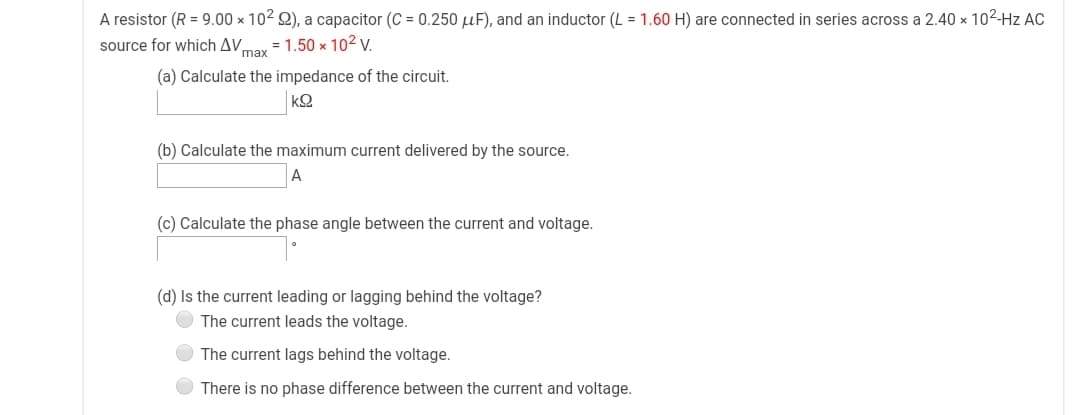A resistor (R = 9.00 x 102 Q), a capacitor (C = 0.250 µF), and an inductor (L = 1.60 H) are connected in series across a 2.40 × 102-Hz AC source for which AV. max = 1.50 x 102 v. (a) Calculate the impedance of the circuit. (b) Calculate the maximum current delivered by the source. (c) Calculate the phase angle between the current and voltage. (d) Is the current leading or lagging behind the voltage? The current leads the voltage. The current lags behind the voltage. O There is no phase difference between the current and voltage.
A resistor (R = 9.00 x 102 Q), a capacitor (C = 0.250 µF), and an inductor (L = 1.60 H) are connected in series across a 2.40 × 102-Hz AC source for which AV. max = 1.50 x 102 v. (a) Calculate the impedance of the circuit. (b) Calculate the maximum current delivered by the source. (c) Calculate the phase angle between the current and voltage. (d) Is the current leading or lagging behind the voltage? The current leads the voltage. The current lags behind the voltage. O There is no phase difference between the current and voltage.
Related questions
Question

Transcribed Image Text:A resistor (R = 9.00 × 102 Q), a capacitor (C = 0.250 µF), and an inductor (L = 1.60 H) are connected in series across a 2.40 × 102-Hz AC
source for which AV.
max
= 1.50 x 102 v.
(a) Calculate the impedance of the circuit.
(b) Calculate the maximum current delivered by the source.
(c) Calculate the phase angle between the current and voltage.
(d) Is the current leading or lagging behind the voltage?
The current leads the voltage.
The current lags behind the voltage.
There is no phase difference between the current and voltage.
Expert Solution
This question has been solved!
Explore an expertly crafted, step-by-step solution for a thorough understanding of key concepts.
Step by step
Solved in 2 steps
